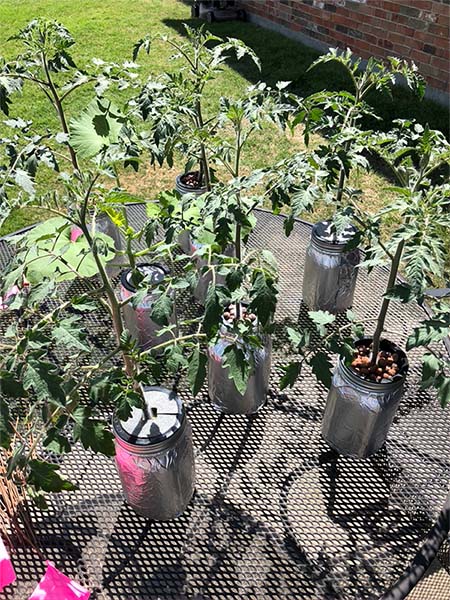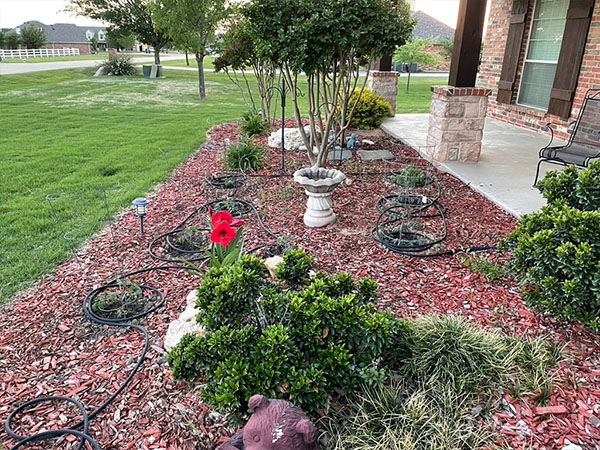Can You Transplant Hydroponic Plants Into Soil?
If you are wondering if you can transplant hydroponically grown plants into soil, the answer is yes. Hydroponic plants can be transplanted into soil and they can thrive if done correctly. It’s important to note that there may be some adjustments needed for the plants to adapt to the new growing medium. The roots of hydroponically grown plants are accustomed to a nutrient-rich water solution, so when transitioning to soil, they may initially struggle to extract nutrients from the soil.
Plants grown in one growing medium are conditioned to thrive in the environment they “grew up in” so when you transplant them, they need a period of adjustment. If your plants were raised indoors, you will also want to consider hardening them off. This means to let them get acclimated to their new environment by taking them outside for a bit.
Some plants do very well when transplanted, such as tomatoes, basil, squash and beans. While others my struggle a bit at first, like cilantro or green onions. But almost all plants can be transplanted. I use the Kratky method of hydroponics indoors and have good success transplanting my hydroponic plants into soil.
Are there risks in transplanting from hydroponic to soil?
Yes, there are potential risks associated with transplanting hydroponic plants into soil. Some of these risks include:
- Transplant shock: Moving plants from one growing medium to another can cause stress and shock to the plants, leading to wilting, yellowing of leaves, or even death if not managed properly.
- Root damage: Handling the roots during the transplanting process can result in damage, which may impede the plant’s ability to establish itself in the new soil.
- Soil issues: The soil into which the hydroponic plants are transplanted may harbor pests, diseases, or nutrient imbalances that could negatively affect plant health.
- Environmental factors: Outdoor conditions such as temperature fluctuations, excessive sunlight, strong winds, or heavy rain can pose challenges to newly transplanted plants, especially if they have not been adequately hardened off.
- Incompatibility with soil: Some plants may struggle to adapt to soil conditions after being grown hydroponically, particularly if they require specific soil pH, drainage, or nutrient levels.
To mitigate these risks, it’s important to carefully plan and execute the transplanting process, ensuring proper soil preparation, gentle handling of the plants, and gradual acclimatization to outdoor conditions. Monitoring the transplanted plants closely and providing appropriate care and support can help minimize the risks and increase the chances of successful establishment in soil.
How do I transplant hydroponic plants from nutrient solution to soil?
To successfully transplant hydroponic plants into soil, follow these steps:
- Prepare the soil: Ensure the soil is well-draining and nutrient-rich. Amend the soil with compost or organic matter to improve its fertility.
- Remove the plant from the hydroponic system: Gently remove the plant from its hydroponic container, being careful not to damage the roots.
- Rinse off excess hydroponic solution: If there is any remaining nutrient solution on the roots, rinse them with water to remove it.
- Plant in soil: Dig a hole in the soil slightly larger than the root ball of the plant. Place the plant in the hole and backfill with soil, pressing gently to secure the plant in place.
- Water thoroughly: After planting, water the soil thoroughly to help settle it around the roots and ensure the plant has access to moisture.
- Monitor and adjust: Keep an eye on the transplanted plant and monitor its progress. It may take some time for the plant to adjust to the new growing medium, so be patient. You may need to make adjustments to watering and nutrient levels as needed.
Overall, while it is possible to transplant hydroponic plants into soil, it’s essential to provide proper care and monitoring to help them successfully adapt.
Hardening off Hydroponic Plants – Going from Indoors to Outdoors
 If your plants are grown indoors, you should harden them off before sticking them in the ground outside. To harden off plants is to gradually acclimate them to outdoor conditions before transplanting them into the garden permanently. Here’s a step-by-step guide on how to harden off plants:
If your plants are grown indoors, you should harden them off before sticking them in the ground outside. To harden off plants is to gradually acclimate them to outdoor conditions before transplanting them into the garden permanently. Here’s a step-by-step guide on how to harden off plants:
- Start indoors: If you’ve been growing your plants indoors or in a greenhouse, begin the hardening off process about 7-10 days before you plan to transplant them outdoors.
- Choose the right time: Select a period of mild weather for hardening off, avoiding extremes in temperature, wind, or precipitation.
- Begin slowly: On the first day, place your plants outdoors in a sheltered location for just a few hours, preferably during the mildest part of the day. Protect them from direct sunlight, strong winds, and heavy rain.
- Gradually increase exposure: Over the next few days, gradually increase the amount of time your plants spend outdoors, as well as the exposure to sunlight and wind. Aim to extend their outdoor time by 1-2 hours each day.
- Monitor conditions: Keep a close eye on your plants during the hardening off process. Watch for signs of stress, such as wilting or yellowing leaves, and adjust their exposure accordingly. If the weather turns unfavorable, bring the plants indoors or provide temporary protection.
- Water and fertilize: Ensure that your plants are adequately watered during the hardening off period, as outdoor conditions may cause them to dry out more quickly than indoors. Avoid over-fertilizing, as this can stress the plants.
- Transplant carefully: Once your plants have been hardened off successfully, they are ready to be transplanted into the garden. Choose a day with mild weather for transplanting, and handle the plants carefully to minimize root disturbance.
Alternatives to Transplanting in Soil
The biggest alternative is to continue their life in hydroponic containers. If you are wanting to move indoor plants outdoors, you can easily use the Kratky method outdoors as well. Containers can be buried in the ground for example, providing insulation and still maintaining a hydroponic system. You can also move the plants to a different method of hydroponics, such as the drip method, which works great outdoors.
Plants that Transplant Well from Hydroponic Nutrients to Soil
While you can transplant any plant really, these plants are very robust and will do well and even thrive when transplanted.
I often use hydroponics indoors to start my seedlings. However, if the goal is to move your plants outdoors and you are just getting a head start on your seeds, you may consider simply starting them in soil from the beginning. I have started my seeds in soil next to my hydroponic plants in the same space.
Tips for Transplanting from Hydroponics to Soil
- Prepare the soil: Ensure the soil is well-draining and enriched with organic matter to provide nutrients for the plants.
- Choose the right time: Select a time for transplanting when the weather is mild and there is minimal stress on the plants.
- Harden off the plants: If the hydroponic plants have been grown indoors, gradually acclimate them to outdoor conditions before transplanting to reduce shock.
- Rinse the roots: Before transplanting, rinse the roots of the hydroponic plants to remove any excess nutrient solution.
- Handle roots gently: When removing the plants from the hydroponic system, handle the roots with care to avoid damage.
- Dig proper planting holes: Dig planting holes in the soil that are large enough to accommodate the root system of each plant.
- Backfill with soil: After placing the plants in the planting holes, backfill around the roots with soil, gently pressing to remove air pockets.
- Water thoroughly: Water the soil around the transplanted plants thoroughly to help settle the soil and provide moisture for root growth.
- Monitor closely: Keep a close eye on the transplanted plants in the days following transplanting, watching for signs of stress such as wilting or yellowing leaves.
- Provide support if needed: Some transplanted plants may benefit from support, such as stakes or cages, to help them adjust to their new environment.
In conclusion, transplanting hydroponic plants into soil can be a rewarding and fulfilling experience for gardeners of all levels. By following the proper techniques outlined in our guide, you can successfully transition your plants from their hydroponic environment to soil, unlocking a new realm of growth and potential. Whether you’re seeking to explore different growing methods or simply looking to diversify your gardening practices, this process offers an opportunity for experimentation and learning. Remember to approach the transplanting process with care, patience, and attention to detail, and soon you’ll be enjoying the vibrant growth and flourishing beauty of your transplanted plants in their new soil home.




